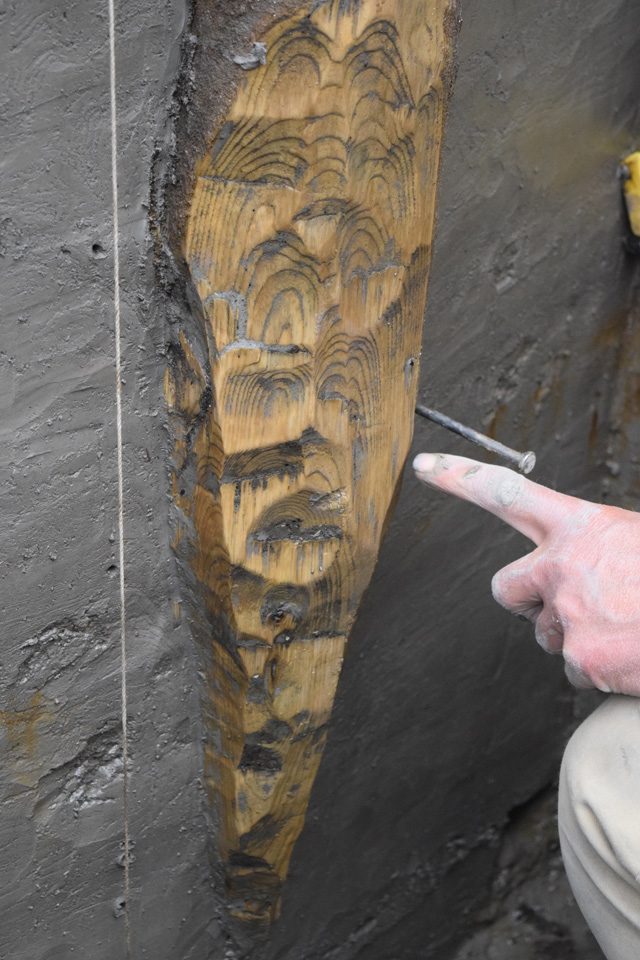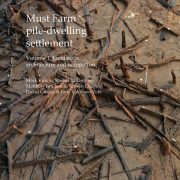Dig Diary 31: Moving Towards the End of Excavation
May 23, 2016
Entering the Final Phases of the Excavation
It seems a long time ago that we stood at the side of the Must Farm quarry and watched as a machine began to remove the first peat we knew was sitting 2m above Bronze Age archaeology. At that point we didn’t realise how spectacular, and important, this archaeology would be. Even the evaluation in 2006 couldn’t prepare us for the density and concentration of remarkable, well-preserved material.

Image from the first day of the project in August 2015. At this stage we weren’t expecting such a well-preserved and complete Bronze Age settlement.
Now, almost 10 months on from that first day on site, we are beginning to enter the final stretch of our work in the field. This last stage of the excavation is one of the most important as we investigate the material associated with the homes before their destruction. However, beneath these everyday objects we are also finding increasing amounts of evidence from the initial construction of the settlement. With a site containing such a wealth of incredible evidence, ensuring it is excavated and recorded to a high standard is essential.
We have always been exceptionally lucky with the circumstances leading to the preservation of the archaeology at Must Farm. The combination of the fire that carbonised material and the waterlogging which preserved most of the organics is a rare situation. We are also very fortunate in terms of the stratigraphy of the excavation. As explained in previous diary entries, there is a distinct separation created between the buoyant wood and the heavier objects.
In effect this created two layers, wood mass and occupation material, that made it clearer for us to excavate. What is even better for us, is that below the occupation from the settlement are the sterile silts of the river channel. In essence, these shell-rich silts act as a “blank canvas” on which the settlement was built and material was deposited. As we work carefully and methodically through the archaeology from beneath the stilted structures, once we reach these shelly sediments from the river channel we can be confident the archaeology finishes.

Image of unburnt clay patches sitting above areas of the clean, “sterile” shelly river sediments. These sediments effectively mark the beginning of the sediment and contain little archaeology.
In the last few weeks, we have reached this sterile river sediment in a number of areas of the excavation. Admittedly, these areas are usually in archaeologically “quieter” portions of the settlement, usually close to the palisade or outside the extent of the homes. Even so, it feels like progress is definitely being made and we can actually begin to really see the work that we have done.
We have the largest team on site since the beginning of the project, with just over 15 archaeologists working through the week to get the excavation completed. This involves having people excavating, cleaning, recording, carrying out photogrammetry, photographing material, removing wood, processing environmental samples and illustrating timbers. It is a very busy site at the moment and requires a lot of coordination to approach each area as efficiently as possible. With such densely packed and, sometimes, complex archaeology to tackle, it is certainly testing our abilities and skills. At the same time, we’d all agree this is one of the most rewarding and exciting projects that we’ve ever worked on.
Working Backwards in Time
One of the key aspects of archaeology is that we work backwards in time: beginning with the latest activity to happen at a site before eventually reaching its earliest stages. This is sometimes a challenging concept to get to grips with and can lead to some slightly unusual results. Working backwards through time often means you identify the biggest “stories” or events in a site’s history first. Here at Must Farm, we quickly realised the size and extent of the settlement and that its life ended as a result of a catastrophic fire.

Image of three ceramic storage vessels, stacked inside one another. Now that we are in the deposits containing more material from the settlement we can begin to examine it more closely and start to gather more detail about the lives of the people who lived here.
However, it is only now at this late stage of the excavation that we are beginning to focus in on the subtler details: details that tell us about the lives of the people living in the homes here. Not only is this coming from the objects and materials they were using; we are also finding evidence of how they were using them. This might sound fairly obvious for items such as querns and storage jars. Yet, even these objects can reveal more information such as the type of materials being stored and the condition they were in when the fire happened. Similarly, careful analysis of querns can reveal where their stone was sourced from alongside particular patterns of use.
It is now that we are beginning to get an idea of how large the assemblage of material really is. Once we had identified our various houses and structures around the settlement, we had no real way of knowing what could be in them and in what quantities. Now that we are much further into the excavation we are able to finally start to realise just how much material we are unearthing. The quantities of artefacts emerging from the river sediments is truly fantastic and is providing us with what seems to be the complete contents of multiple Bronze Age homes. As archaeologists deal with unpicking and understanding how people in the past lived, the evidence can’t get much better than this!

Hundreds of woodchips from the construction of the palisade. Recording these in detail is essential and we hope to spot patterns in their distribution to tell us about the construction process.
Over the past few weeks we have been discussing our current thoughts and theories concerning how these homes were built. As we get to the end of the project, and the earliest deposits on site, we are now getting insights into the construction of the settlement. We have already been exploring the areas alongside the palisade, discovering hundreds of woodchips and small pieces of timber debris. These are very clear signs of the timbers for the palisade being worked and shaped at the settlement, rather than being prepared elsewhere and then brought in.
While on-site analysis and understanding of these dense clusters of woodchips is relatively limited, much more detail can hopefully be unpicked during post-excavation. Each woodchip is recorded with aspects such as dimensions, wood species and working information being logged. This means that when we study the plans and 3D models of the areas close to the palisade we should be able to detect any patterns in distribution. Potentially, this could give us an understanding of the how palisade was constructed.

Close-up image of the tip of a structural upright. Note the preserved tool marks which look fresh.
We have also begun to excavate and record some of the large structural uprights that would have supported the roundhouses. From early on we suspected these posts would have been driven deeply into the channel to support the raised homes. However, it was only this week we began to realise exactly how deep that would have been. Excavating one of the posts in the outer ring of uprights from Roundhouse One revealed that it had been driven into the sediments to a depth of 2.6 metres.

Image of one of the structural uprights from Roundhouse One. This one measures approximately 2m although many are longer.
How did people manage to drive these timbers so deeply into the dense sediment underneath the river channel? It is a great question given the lack of technology we associate with doing similar activities today. It seems likely that they simply used momentum and brute force to put weight on the top of the post and gradually work it downwards. The sharp points on the tips of these posts would have helped but it cannot have been an easy job.
Over the last few months of the project we will be uncovering more evidence relating to the earliest aspects of the settlement alongside the activity that would have taken place here. This is the archaeology that will really help us to refine and develop our understanding, allowing us to see the settlement in a much more detailed manner. As the project draws to a close, the activity on site really intensifies. With a larger team, working on a lot of different aspects of archaeology, each day gives us more and more insight and information about the Must Farm settlement. Over the next few weeks we will be sharing these latest findings as they happen on site.
Related stories
Dig Diary 34: Examining our Clay and Turf Material
June 13, 2016
Dig Diary 33: The Palisade and its Construction
June 6, 2016
Dig Diary 31: Moving Towards the End of Excavation
May 23, 2016
Dig Diary 27: Pottery
April 25, 2016
Learn more
About
The Must Farm pile-dwelling settlement was excavated by the Cambridge Archaeological Unit with funding from Historic England and Forterra.Publications
Read the Open Access publications the Must Farm pile-dwelling settlement: Volume 1. Landscape, architecture and occupation and Volume 2. Specialist reports.Post-Ex Diaries
Our work on-site has finished but lots more investigation is taking place as we study both the material and the evidence we recovered. ...read more
Discoveries
See some of the discoveries from the Must Farm pile-dwelling settlement.
Making Must Farm
Find out about our work with AncientCraft recreating Must Farm’s material.
FAQs
Further information on the Must Farm project.


















